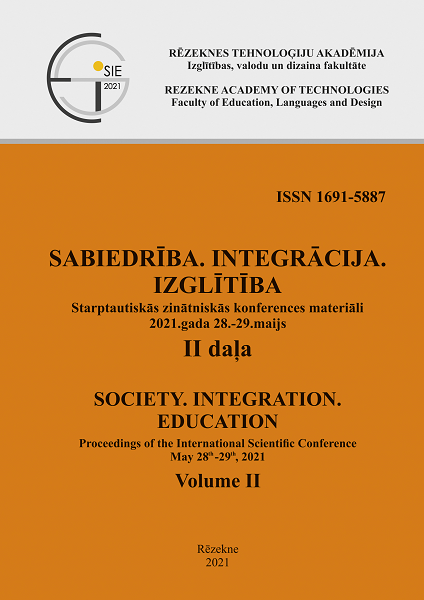THE USE OF PROJECT TECHNOLOGY TO INTRODUCE SCHOOLCHILDREN TO ELEMENTS OF THE GENERAL TOPOLOGY
DOI:
https://doi.org/10.17770/sie2021vol2.6211Keywords:
4C-competence, continuity, elements of general topology, homeomorphism, mathematical modeling, project learning technology, schoolAbstract
Preparing a student with project skills is one of the urgent tasks facing education. At present, the general education school of Russia is moving to new educational standards, which provide for the mandatory formation of students' skills in using project activities. The article contains an analysis of the experience of involving students of different age groups in project activities during their acquaintance with the basic topological concepts within the framework of the author's elective discipline "Get to know topology".
At the preparatory stage of teaching, the content of the modern section of mathematics was reasonably selected, different types of practical tasks were modeled, the topic of projects, possible options for the product of project activities, assessment criteria were selected, questionnaires were developed.
The article describes the results of experimental teaching, which was carried out for three years in educational institutions of different levels. The article is illustrated with examples of methods of organizing project activities in the course "Get to know topology" and approaches to evaluating project products; the analysis of questionnaires of different groups of students was carried out. The results of the study confirm that project-based learning increases the involvement and interest of schoolchildren in mathematics, allows them to understand a new problem, contributes to the development of communication and cooperation skills of students, creates conditions for the development of students' creativity.
Downloads
References
Alexandrov A.D. (2016). Pedagogical articles from different years St. Petersburg: SMIO Press.
Bell, S. (2010). Project-based learning for the 21st century: skills for the future. The Clearing House: A Journal of Educational Strategies, Issues and Ideas, 83(2), 39-43. DOI: https://doi.org/10.1080/00098650903505415
Blumenfeld, P.C., Soloway, E., Marx, R.W., Krajcik, J.S., Guzdial, M., & Palincsar, A. (1991). Motivating project-based learning: Sustaining the doing, supporting the learning. Educational Psychologist, 26 (3-4), 369–398. DOI: https://doi.org/10.1080/00461520.1991.9653139
Dul'zon, A.A. (2010). Opyt problemno-orientirovannogo i proektno-organizovannogo obuchenija. Vysshee obrazovanie v Rossii, 10, 42-48.
Helle, L., Tynjälä, P., & Olkinuora, E. (2006). Project-based learning in post-secondary education – theory, practice and rubber sling shots. Higher Education, 51, 287-314. DOI: https://doi.org/10.1007/s10734-004-6386-5
Kokotsaki, D., Menzies, V., & Wiggins, A. (2016). Project-based learning: A review of the literature. Sage Journals, Improving Schools 19(3), 267-277. DOI: https://doi.org/10.1177/1365480216659733
Lang, L. (2018). Encouraging Deep Learning through Collaborative Projects and Public Exhibition. People: International Journal of Social Sciences, 3(3), 1108-1124.
Medvedeva, I., Martynyuk, O., Pan’kova, S., & Solovyova, I. (2018). Assessment of universal competencies of students. Society. Integration. Education. Proceedings of the International Scientific Conference, Rēzekne, Volume I, 384-393. DOI: https://doi.org/10.17770/sie2019vol1.3767
Medvedeva, I., Martynyuk, O., Pan’kova, S., & Solovyova, I. (2020). On the Readiness of First-Year Students for Project-Oriented Training in Higher Education. Society. Integration. Education. Proceedings of the International Scientific Conference, Rezekne, Volume II, 108-118. DOI: https://doi.org/10.17770/sie2020vol2.5086
Ryabova, O. (2019). The use of mathematical models of topological objects in the study of properties of topological manifolds. The Youth of the 21st Century: Education, Science, Innovations: Proceedings of VI International Conference for Students, Postgraduates and Young Scientists, Vitebsk, December 12, 2019. Vitebsk: Vitebsk State University named after P.M. Masherov, 28-29.


